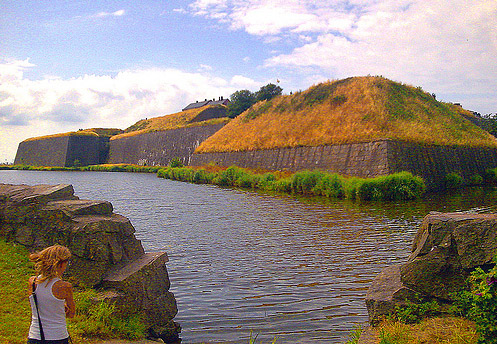 |
Varberg Fortress
Varberg, Sweden
|
|
 |
On the night of November 22 1286, Denmark's King Eric V (1249-1286) was hacked to death in the village of Finderup by a group of Danish noblemen disguised as Franciscan monks. Whether or not he was actually guilty of this royal hackery, count Jacob Nielsen (d.1309) was found immediately guilty and outlawed by King Eric VI Menved (1274-1319)...who was all of twelve when his dad the V was murdered, so his mom actually did the outlawing.
Nielsen, who may have been found guilty more for his traitorous allegiance to Norway than for any participation in his king's murder, found himself in sudden need of fortification. The count of Halland in what was then Danish territory, Nielsen chose a defensible location on the coast of his county and built Wardbergh, or "Watch Hill," from 1287 to 1300.
|
 |
|
|
The initial fortification was made into a castle over the following decades, paid for by Norway. Nielsen was booted from the premises in 1305, when the region became Norwegian. Various Danish/Swedish/Norwegian kings stayed there at one time or another, depending on whomever claimed the county at the moment. The castle came under attack by invading Germans in 1536 and Swedes in 1563, just to name two of many belligerents. Since attacking this castle proved to be such an irresistible attraction for visitors, Danish engineer Hans van Steenwinckel the Younger (1587-1639) was employed to enclose Wardbergh Castle in properly fortish walls at the end of the 16th century (Steenwinckel also did some work on Kronborg Castle), and Varberg Fortress was born. The fort took its present shape in the 1640's, when Steenwinckel's additions were further fortified.
|
 Somebody's girlfriend looks cold and unhappy. Buck up, girlfriend! You're at the pointy corner of a starfort, perhaps the most cosmically satisfying place to be in the universe!! Somebody's girlfriend looks cold and unhappy. Buck up, girlfriend! You're at the pointy corner of a starfort, perhaps the most cosmically satisfying place to be in the universe!! |
 |
In 1645, the region became Swedish, which began a 200-year downward spiral for the fort. In 1822 Varberg Fortress fell off the list of Sweden's active military installations, and soon the city's inhabitants were removing stones from the fort's walls to build other, less historically interesting things.
Fortunately for Swedish criminals, the fortress was made a "Crown Jail" in 1848, in which capacity it served until 1930. How much fun would it be to be imprisoned in an historic starfort!? |
|
An unheated historic starfort, at that. Various restoration efforts over the next 40 years brought Varberg Fortress back into shape, and today it houses the Halland County Museum.
|
|
|
|
|
|
 |




